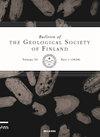利用尾矿中的有源地震数据:折射和MASW分析、弹性参数和水文地质条件
IF 1.3
4区 地球科学
Q2 GEOLOGY
引用次数: 2
摘要
我们将有源地震方法应用于尾矿设施弹性参数的解释,这对评估稳定性和地震反应至关重要。该方法在同一数据集上使用不同的分析方法,即传统的地震折射(SR)来确定纵波速度(Vp),多通道表面波分析(MASW)来估计剪切波速(Vs)。地震速度与尾矿物理方法相结合,揭示了弹性参数和水文地质条件方面的可解释数据。结果确定了Vp和Vs之间的经验线性关系,这是尾矿等松散介质特有的,并表明水文地质条件的可变性影响弹性地震响应(Vp和Vs)和弹性参数。对弹性参数的分析确定了调查时尾矿的状态。体积模量K(将静水应力的变化与体积应变联系起来)在1.0−2.0 GPa之间占主导地位。尾矿介质中的杨氏模量E在0.15−0.23 GPa的低范围内。所有截面的泊松比值都在0.37−0.49的上限范围内,这意味着尾矿介质在轴向压缩下极易发生横向变形。本文章由计算机程序翻译,如有差异,请以英文原文为准。
Leveraging active-source seismic data in mining tailings: Refraction and MASW analysis, elastic parameters, and hydrogeological conditions
We applied active-source seismic method for the interpretation of elastic parameters in tailings facilities which is essential for evaluating stability and seismic response. The methodology uses different analysis methods on the same dataset, i.e., conventional seismic refraction (SR) to determine compressional-wave velocity (Vp) and multichannel analysis of surface wave (MASW) to estimate shear-wave velocity (Vs). Seismic velocities in conjunction with tailings physics approach revealed interpretable data in terms of elastic parameters and hydrogeological conditions. The results determined the empirical linear relationships between Vp and Vs that are particular to an unconsolidated media such as tailings and showed that variability of hydrogeological conditions influences the elastic seismic response (Vp and Vs) and the elastic parameters. The analysis of the elastic parameters identified the state condition of the tailings at the time of the survey. The Bulk modulus K that relates the change in hydrostatic stress to the volumetric strain was predominant between 1.0−2.0 GPa. The Young’s modulus E in the tailings media was in the low range of 0.15−0.23 GPa. Poisson’s ratio values in all sections were in the upper limit in the range of 0.37−0.49, meaning that the tailings media is highly susceptible to transverse deformation under axial compression.
求助全文
通过发布文献求助,成功后即可免费获取论文全文。
去求助
来源期刊
CiteScore
1.30
自引率
0.00%
发文量
5
审稿时长
>12 weeks
期刊介绍:
Bulletin of the Geological Society of Finland (BGSF) publishes research articles and short communications in all branches of geosciences. Contributions from outside Finland are welcome, provided that they contain material relevant to Finnish geology or are of general interest.

 求助内容:
求助内容: 应助结果提醒方式:
应助结果提醒方式:


